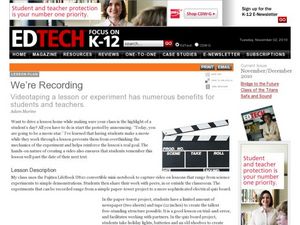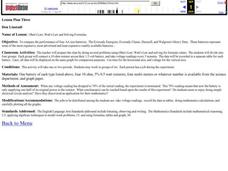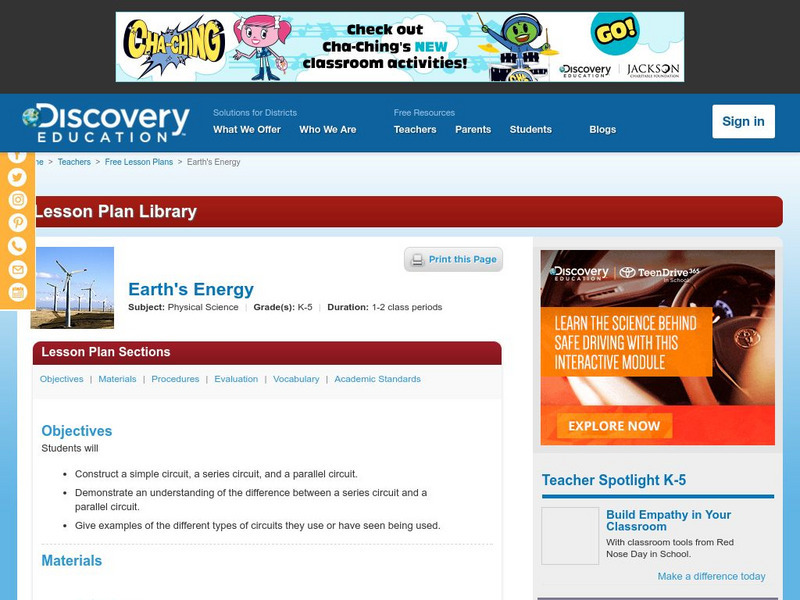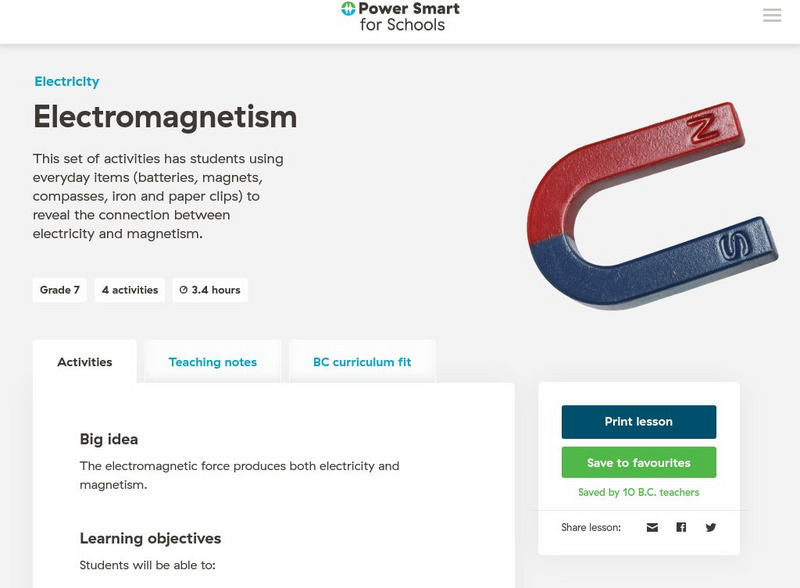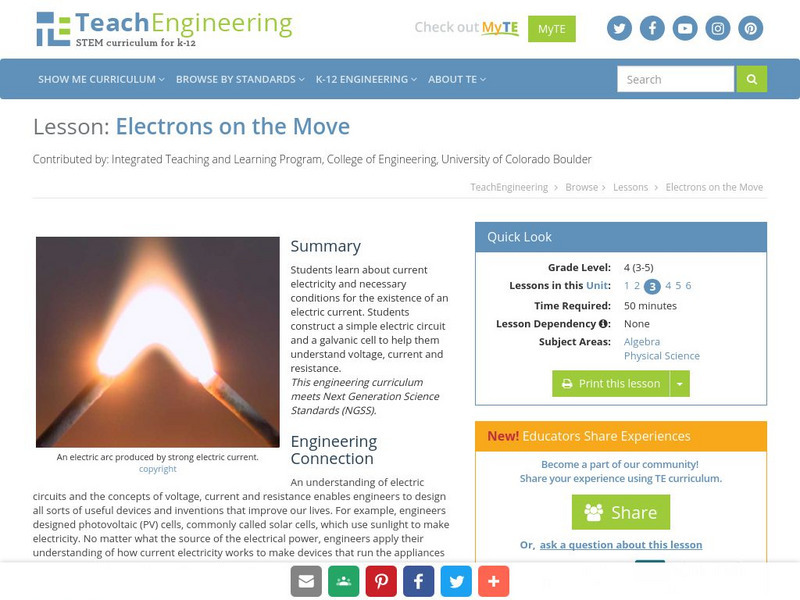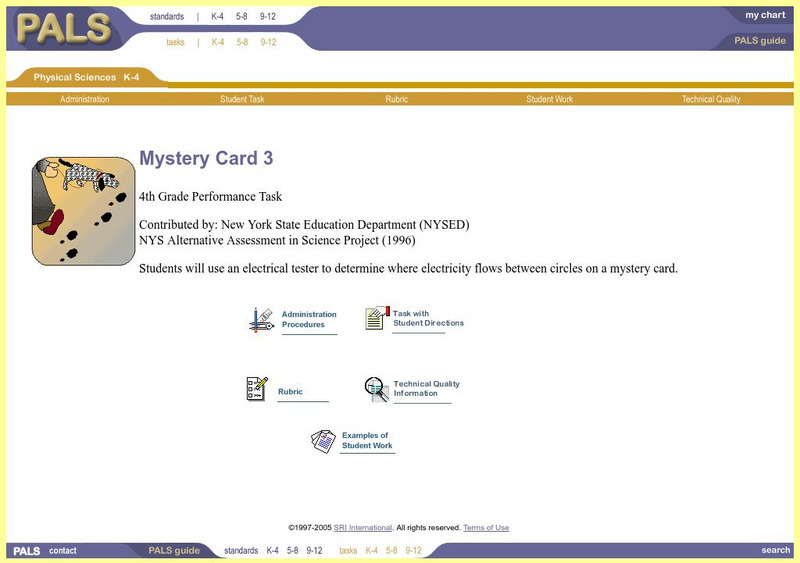Curated OER
Processing the Future: Innovations in Computer Technology
Students visit a website that takes them inside of a computer to see how it works. They investigate the people who contributed to computer technology.
Curated OER
Making A Compass
This interesting science instructional activity is about the compass. Students make a compass out of a magnet, sewing needle, cork, and a glass dish. The instructional activity includes both a pre and post-test for the students to take,...
Curated OER
Plant Cycles
Young scholars identify plants parts and their functions. In this plant cycle lesson, students examine parts of plants and how the parts help them survive in its environment. Young scholars use graphic organizers, the internet, books...
Curated OER
Characteristics of Energy
Students explore Earth science by completing energy worksheets in class. In this energy forms lesson plan, students identify and define a list of energy vocabulary terms and a K-W-L chart. Students view a matter video clip in class and...
Pennsylvania Department of Education
Energy in Motion
Fifth graders explore energy transfer. In this thermal energy lesson, 5th graders stretch rubber bands several times and estimate the band's temperature change. Students identify this action as an example of thermal energy. Students...
Curated OER
The Invention of the Telegraph
Students study the history of telegraph invention. In this technology lesson, students build their own Morse Telegraph System. They discuss how this invention benefits the society.
Curated OER
Red Shift, Blue Shift
Pupils demonstrate how stellar spectra measures a star's motion relative to Earth along the line of sight.
Curated OER
We're Recording
Students record their experiments or lessons using a video camera. In this technology lesson plan, students explain to the camera what they have learned. They watch these together to help reinforce a lesson plan.
Curated OER
Making Energy "trails"
Students explore ten different stations that demonstrate either chemical, kinetic, or mechanical energy. They examine the way energy is transferred during each station's hands-on activity. Stations include vinegar and baking soda,...
Curated OER
Food Webs
Fourth graders discover how organisms depend upon each other in an ecosystem. In this ecosystems lesson plan, 4th graders use food webs to discuss the interdependence between organisms in an ecosystem.
Curated OER
Ohm's Law, Watt's Law and Solving Formulas.
Young scholars, in groups, connect a 10 ohm resistor across their 1.5 volt battery, and take voltage readings every 5 minutes.
TryEngineering
Try Engineering: Series and Parallel Circuits
The core of this lesson is simple circuits and the differences between parallel and series circuit design. Students perform experiments to test the differences between the two circuit designs using low voltage light bulbs.
TryEngineering
Try Engineering: Electric Messages: Then and Now
Lesson investigates electronic communication from the Morse Code system to text messaging. To learn about this, students construct simple circuits, send messages to each other, and explore the history and impact of communication.
Discovery Education
Discovery Education: Earth's Energy
A hands-on instructional activity for helping students understand simple circuits, series circuits, and parallel circuits, and the differences between the three.
Other
Bc Hydro: Power Smart for Schools: Electromagnetism
This set of activities has students using everyday items (batteries, magnets, compasses, iron and paper clips) to reveal the connection between electricity and magnetism. Ideally, students will already have experience building simple...
TryEngineering
Try Engineering: Electric Switches
Lesson focuses on how switches control the flow of electricity. Students are posed with the challenge of designing and building a simple switch into an electric circuit.
Science Education Resource Center at Carleton College
Serc: Introduction to Electricity by Creating a Light Up Quiz Board
In this activity, young scholars will learn how to create a simple circuit. They will create a matching quiz board that will light up when the correct pair is selected using electricity vocabulary from the text.
American Geosciences Institute
American Geosciences Institute: Earth Science Week: Mineral Electrical Conductivity
The purpose of this activity is to test the conductivity of various minerals with a simple electrical circuit and draw conclusions about which ones would be used in electronics.
Science and Mathematics Initiative for Learning Enhancement (SMILE)
Smile: Simple Circuitry and Series Circuit
A teacher lesson plan which could be easily converted into an idea for a student project or presentation. This page describes an activity in which the basic nature of a circuit and the concepts of a series circuit are investigated....
Science Education Resource Center at Carleton College
Serc: Learning the Science Behind Electricity
Following a PowerPoint lecture, students will participate in a laboratory investigation where they dissect a disposable camera.
TeachEngineering
Teach Engineering: Electrons on the Move
Students learn about current electricity and necessary conditions for the existence of an electric current. Students construct a simple electric circuit and a galvanic cell to help them understand voltage, current and resistance.
SRI International
Performance Assessment Links in Science: Mystery Card 3
Straightforward introduction to electrical circuits using minimal materials and time. Students learn about the basics of electrical circuits by experimenting with "mystery cards" -- index cards with hidden aluminum foil used to conduct...
TeachEngineering
Teach Engineering: How Does a Robot Work?
This instructional activity introduces electricity, batteries and motors using a LEGO MINDSTORMS NXT robot. The associated activity guides students to build a simple LEGO NXT set-up and see the practical implementation of the concepts...
Science and Mathematics Initiative for Learning Enhancement (SMILE)
Smile: Ohm's Law
For the teacher planning a lesson plan or for the student preparing for a project or presentation. This page describes a series of simple activities related to the voltage-current-resistance relationship.









